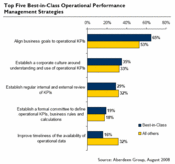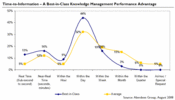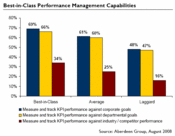Are your daily decisions based on fact? A new report by Aberdeen Group finds that best-in-class companies succeed by finding the right key performance metrics and tying day-to-day decisions to larger corporate goals.

Businesses thrive or fail based on their ability to identify, define, track, and act upon Key Performance Indicators (KPIs). Executives and line-of-business management are increasingly feeling the pressure to enable timelier and more accurate decisions in order to improve operational efficiencies. The faster and more accurately KPIs can be accessed, reviewed, analyzed, and acted upon, the better an organization can manage day-to-day operations and customer interactions.
Companies are focusing on obtaining solutions that address specific business pressures driving operational performance today. These include the need to:
Improve executive visibility to operational drivers. Few companies have achieved greater than a beginning level of maturity when it comes to addressing operational data within a time frame that can affect performance improvement. In fact, 24% of respondents have not yet addressed operational data with any reporting or analytics capabilities.
Replace "gut-feel" decisions with "fact-based" decisions. Interviews with respondents revealed that many operational decisions are based on gut-feel because information is not available soon enough after a business event occurs.
Gain an understanding of operational performance drivers. There are many operational "moving parts" within the organization.
In June and July of 2008, Aberdeen Group investigated a wide spectrum of operational performance management capabilities through a primary survey research program. Based on responses from more than 200 organizations, Aberdeen uncovered the strategies, actions, technology investments, and services that Best-in-Class companies are using to improve operational performance. As explained in this executive summary of Aberdeen's "Operational KPIs and Performance Management" report, Best-in-Class companies tie day-to-day operational decisions and performance to the successful attainment of corporate goals.
PERFORMANCE BECOMES A PRIORITY
Performance management metrics have traditionally been accessed through simple means such as spreadsheets and static reports, as well as advanced methods involving Business Intelligence (BI) technologies such as scorecards, dashboards, operational reporting, analytics, and "automated alerting." Operational managers are increasingly demanding visibility into day-to-day metrics in order to align operational business activity with corporate objectives. This means they must gather, track, analyze, and act upon KPIs that can change multiple times throughout the business day or week.
The creation, management, and continual review of KPIs can be a difficult process, particularly when large, complex data volumes are combined with rapidly changing business dynamics. Projects also often involve the integration of data from disparate sources, complex calculations to derive accurate KPIs, and a host of infrastructure requirements to deliver the information in a meaningful format (reports / dashboards, scorecards, alerts) and via an effective medium (desktop, Web, remote access, email, PDAs, mobile devices).
Operational performance is rapidly becoming a top priority of business intelligence and performance management projects. Respondent interviews revealed that activity and projects are focused on the desire to improve customer service, expense management, and sales operations performance. While this reflects the business areas most concerned, executives are struggling to gain visibility into the operational performance driving the business. Asked to identify pressures driving operational performance management, respondents cited these top-five business demands:
32% Improve executive visibility into operational drivers
29% Replace "gut-feel" decisions with "fact-based" decisions
26% Identify and understand operational performance drivers
23% Control increasing operational costs
23% Accelerate access to operational performance information
Nearly one-third of all respondents are prioritizing executive management visibility into operational performance as the top pressure driving their focus and investment into identifying and managing operational KPIs. This drive toward improved visibility is an internally-focused pressure that directly addresses to the next most reported business concern – replacing "gut-level" decisions with "fact-based" decisions. But in order to accomplish this, companies clearly must have a firm grip on the actual operational performance drivers, and the definition and calculation of operational KPIs that will inevitably produce the desired visibility.
The following sections provide a detailed analysis of the operational performance improvements that "Best-in-Class" companies have achieved through their strategic and tactical actions and organizational investments.
BENCHMARKING BEST-IN-CLASS STRATEGIES
What are Best-in-Class (BIC) companies? Aberdeen used four performance metrics to determine Best-in-Class performance:
Customer satisfaction: percent year-over-year change in customer satisfaction (past 24 months)
Customer issue resolution capability: percent year-over-year change in the speed with which customer issues are resolved (past 24 months)
Conversion of inquiries to sales leads: percent year-over-year change in the rate at which inquiries are converted to leads (past 24 months)
Sales forecast-to-plan performance: percent year-over-year change in the accuracy of sales forecast-to-plan measurement (past 24 months)
Best-in-Class companies were defined as the top 20% in their aggregate scores for the four measures above. Industry Average companies are the middle 50% of aggregate performance scorers. Laggards are the bottom 30% of aggregate performance scorers. Aberdeen's survey results show that the firms enjoying Best-in-Class performance shared several common characteristics:
82% of Best-in-Class companies have at least one year of experience in managing operational KPIs, compared with 65% of all other respondents.
52% of Best-in-Class companies use business intelligence capabilities that are embedded within ERP applications in order to define, track, and manage operational KPIs, as compared with only 35% of Industry Average companies, and 19% of Laggards.
Best-in-Class companies have improved customer service program renewal rates by a mean average of 4.7% year-over year, versus a decline in renewal rates of -2.7% among all other respondents.
Best-in-Class companies are focusing on business alignment. This pertains to the ability to tie operational activity and performance to the successful attainment of corporate goals. This single strategy is more than twice as likely than any other to be at the topmost of executives minds as they address their operational performance initiatives.

Top Five Best-In-Class Operational Performance Mangement Strategies
(click image for larger view)
Unlike typical strategic business intelligence initiatives that focus on trend data that is captured over time (weeks, months, years), operational performance initiatives relate to areas of the business that experience change and activity multiple times throughout the business day. This requires the ability to access, capture, integrate, and analyze operational data quickly. Best-in-Class companies have a greater ability to capture operational information in a timely manner than all other respondents (see "Top Five Best-in-Class Operational Performance Management Strategies" chart at right).
BEST-IN-CLASS CAPABILITIES
Aberdeen's analysis of Best-in-Class firms shows that successful operational performance and KPI initiatives depend on a combination of specific capabilities and technology enablers. The research identified several capabilities that these leading companies share in order to achieve operational performance excellence. Process.
As business dynamics change, so too must the KPIs that are used to measure performance. Best-in-Class companies are more than 50% more likely than Industry Average companies and 100% more likely than Laggards to employ a method for identifying, incorporating and reviewing/updating KPIs related to operational performance.
The process of updating KPIs on a continual basis is extremely important when it comes to operational performance. KPIs may become obsolete very quickly. For example, an online retail company that is presenting a new product line on its Web site may set KPIs initially based on past performance of similar products. However, after the first few days of activity, results may indicate a new method for presentation or a new offer type to be introduced. The KPIs used to measure performance, therefore, may need to be altered. Organization.
In addition to having a process for updating KPIs related to operational performance, Best-in-Class companies are also formalizing this process and have formed committees tasked with defining the KPIs. Best-in-Class companies are nearly 40% more likely than Industry Average companies and nearly 50% more likely than Laggards to take this approach.
A formal committee enables an organization to develop specialized KPIs that address the performance of multiple areas of the business. The most successful committees include a cross-discipline team that encompasses IT, business executives, and business end users. Often, the KPIs associated with operational performance involve complex mathematics and formulas integrating information from multiple data sources. Thus, success can depend on the existence of a formal committee dedicated to understanding this information, and applying the necessary business rules and metrics to create appropriate KPIs.
Knowledge Management.
To establish a set of operational KPIs and a performance-driven culture, you need clear and effective corporate communications. In addition, intelligence about industrywide performance will help to guide the performance thresholds that should be pursued based on peer and competitor performance. Finally, any performance measurement capability should be accompanied by an internal training program that helps all stakeholders to understand and buy in to the program.

Time-To-Information: A Best-In-Class Knowledge Management Performance Advantage
(click image for larger view)
Companies are trying to improve efficiencies and performance of many day-to-day operational activities, such as customer interactions, finance and accounting processes, transportation/shipping, sales activity, manufacturing, inventory management, and marketing. Aberdeen research conducted for the September 2007 report, Smart Decisions: The Role of Key Performance Indicators, found that Best-in-Class companies are improving their time-to-information through capabilities, technologies, and services that enable faster delivery of mission-critical information.
Aberdeen has found that over the last year, the time-to-information gap between Best-in-Class and other companies has widened significantly. In fact, Best-in-Class respondents are now more than 65% more likely to obtain information about business events within a day or less as compared to Industry Average companies (see "Time to Information" chart at right).
Performance Management.
As stated earlier, the top business pressure driving companies to focus on operational performance is the desire to elevate visibility of operational performance to executives. Best-in-Class organizations are not only establishing KPIs to measure the company's operational performance over time, but are also obtaining comparative capabilities to ensure that performance measures are in alignment across the organization.

Best-In-Class Performance Management Capabilities
(click image for larger view)
Interviews with executives revealed that it is not enough to simply define KPIs and track them over time. They also need to understand how the indicators relate to performance goals of the group, the company, and how this performance compares to that of competitors. This is achieved through involvement with industry trade associations, integration of data from industry aggregators and integration of data that can be obtained from government agencies.
While Best-in-Class companies have excelled at establishing internal alignment of KPIs to corporate and departmental goals, many still lack the ability to extend these comparisons to industry thresholds and competitor performance figures. Still, Best-in-Class companies are significantly more apt to have this capability than Industry Average and Laggard organizations (see "Best-In-Class Performance Management Capabilities" chart at right).
Best-in-Class companies are also more likely to establish KPIs across a wide range of operational areas of the organization. Aberdeen research has revealed that the more operational areas addressed, the more improvement will be realized across all areas of the business. Aberdeen's research program measured respondents' use of operational performance metrics across a variety of operational business areas, including:
Customer performance — including metrics for customer satisfaction, customer issue resolution speed, customer issue resolution accuracy, and customer retention rate
Service performance — including metrics for service, such as first-call resolution rates, renewal rates, SLA-compliance rates, delivery performance to customer, and product-return rates
Sales operations — including metrics for new pipeline accounts identified, meetings secured, conversion of inquiries to leads, average call closure time, and dials completed per hour, shift, and day
Sales plan/forecast — including metrics for price-to-purchase order accuracy, purchase order fulfillment ratio, quantity earned (revenue can be recognized), forecast-to-plan ratio, and total closed contracts - cumulative.
Technology
Interviews with respondents and survey results revealed that the time, effort, and IT resources required to generate operational reports and analytic capabilities and deliver them to the right end users at the right time is a major factor that inhibits operational performance improvement. This can come as an unwelcome surprise as BI implementations begin to grow in scope from pilot projects to full-production applications encompassing large data sets, complex calculations and algorithms, and diverse, non-technical business users. Technical ability (and the lack thereof) among users typically pushes the job of report generation to the IT department. This not only leads to additional costs in terms of IT resource utilization, but also drives up the headcount required to meet the demand for increasing report and analytical view requests.
Best-in-Class companies have realized that the automation of data integration, report generation, and alerting can improve the speed and ease with which information can be collected, assembled, and delivered to end-users.
Operational performance management capabilities depend on technology disciplines, including:
Data management, data integration and data cleansing
Data modeling and business rules development
Dashboarding and scorecarding with an eye toward easy access and display of information to a variety of technical and non-technical business stakeholders
Automated alerting to enable stakeholders to learn about performance changes as they occur
Survey respondents have also clearly prioritized vendor selection criteria. At the top of the list are "ease of use for end-users" and "integration capabilities with other applications."
WHAT'S NEXT?

Next Department To Be Addressed By Operational KPIs
(click image for larger view)
To achieve Best-in-Class performance, companies must prioritize the areas of the business that will benefit most from operational performance management initiatives. When asked to identify the areas where operational performance management efforts will be directed next, respondents overwhelmingly agreed that customer service is the top priority (see "Next Department to be Addressed by Operational KPIs" chart at right).
In addition to providing the complete results of Aberdeen's July 2008 survey, the complete "Operational KPIs and Performance Management" report includes 16 charts, six tables and more detail on Best-in-Class capabilities. The report also offers eight recommended "Steps to Success" for Laggard, Average and Best-in-Class companies. To download the 27-page report, click here.
About the Author(s)
You May Also Like







